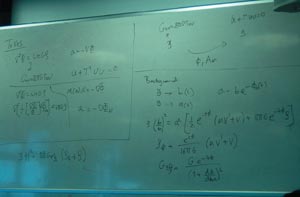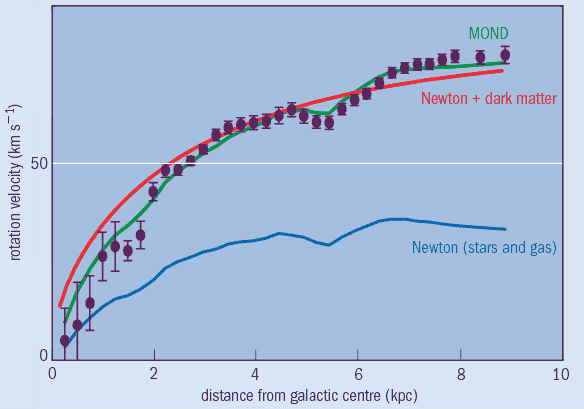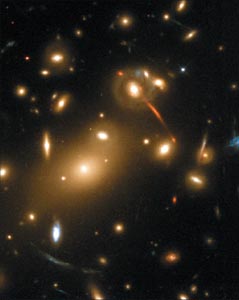Despite decades of searching, the "dark matter" thought to hold galaxies together is still nowhere to be found. Matthew Chalmers describes how some physicists think it makes more sense to change our theory of gravity instead

If you are an academic in a physics department, you are probably used to receiving letters from people who claim to have rewritten the laws of physics. Editors of science magazines are also familiar with such individuals, many of whom take gravity for their victim. Although we should not automatically dismiss these ideas – after all, Einstein was an unknown patent clerk when he rocked the world of physics in 1905 – most fall down because their proponents fail to put them in context with existing knowledge.
The same cannot be said of a growing number of professional physicists who think Einstein’s general theory of relativity is ripe for revision. General relativity is part of the bedrock of modern physics. It describes in elegant mathematical terms how matter causes space-time to curve, and therefore how objects move in a gravitational field. Since it was published in 1916, general relativity has passed every test asked of it with flying colours, and to many physicists the notion that it is wrong is sacrilege.
But the motivation for developing an alternative theory of gravity is compelling. Over the last few years cosmologists have arrived at a simple yet extraordinarily successful model of universe. The trouble is that it requires most of the cosmos to be filled with mysterious stuff that we cannot see. In particular, general relativity – or rather its non-relativistic limit otherwise known as Newtonian gravity – can only correctly describe the dynamics of galaxies if we invoke huge quantities of “dark matter”. Furthermore, an exotic entity called dark energy is necessary to account for the recent discovery that the expansion of the universe is accelerating. Indeed, in the standard model of cosmology, visible matter such as stars, planets and physics textbooks accounts for just 4% of the total universe.
Faced with a lack of direct evidence for dark matter, a small but growing band of physicists is proposing an alternative explanation: that our description of gravity is wrong. And if the discussions at a recent workshop on dark matter and alternative gravities held in April at the Royal Observatory in Edinburgh are anything to go by, they could be in for a bumpy ride.
Seeds of doubt
Dark matter was proposed in 1933 to explain why galaxies in certain clusters move faster than would be possible if they contained only the “baryonic” matter that we can see. A few decades later, similar behaviour was detected in individual galaxies, whereby the rotational velocity of the outermost stars was found not to “drop off” as a function of distance but instead remain flat (see figure). These observations directly contradicted Newtonian gravity, which should hold true in extragalactic regions just as it does on Earth and in the solar system. But by assuming there are “haloes” of invisible matter in and around galactic structures, Newton’s familiar inverse square law is restored.
Although firmly embedded in modern cosmology, dark matter is viewed by many physicists as a fudge factor. “Astronomers have no idea what dark matter is,” says HongSheng Zhao of St Andrews University. “It is whatever is needed to explain the data, rather than a fundamental prediction of particle physics as it was originally.” The situation is reminiscent of one facing astronomers in the 1840s, who in trying to explain anomalies in the orbit of Uranus postulated a new outer planet rather than scrap Newton’s law. The crucial difference, of course, is that Neptune was discovered shortly afterwards, while dark matter remains elusive despite years of dedicated searches.
In 1983, however, Mordehai Milgrom, now at the Weizmann Institute in Israel, claimed he could explain the anomalous rotation of galaxies without invoking dark matter. Instead, he modified Newton’s formula so that under certain circumstances the gravitational force between two bodies decays more gently than the inverse square of the distance between them. The key property of Milgrom’s theory – called modified Newtonian dynamics, or MOND – was that the modified behaviour kicks in below a certain acceleration, rather than distance, scale. Remarkably, Milgrom was able to set the value of this universal parameter such that MOND describes the dynamics of galaxies extremely well, while preserving Newtonian gravity elsewhere.
But any alternative theory of gravity worth its salt has to account for much more than just galaxy dynamics. In particular, it needs to be able to explain the way light is bent by massive objects – a central prediction of general relativity that was dramatically confirmed during the solar eclipse of 1919. The most striking manifestation of this effect is gravitational lensing, whereby galaxies or clusters of galaxies cause light from background objects to appear as if it has come from several different sources. As with the dynamics of galaxies, however, general relativity is unable to account for the strength of some gravitational lenses without adding appropriate distributions of dark matter “by hand”.
Being rooted in Newtonian mechanics, MOND had no hope of explaining the bending of light. Moreover, Milgrom’s simple formula violated several basic laws of physics, such as the conservation of momentum. This prompted theorists in the 1980s and 1990s, notably Milgrom, Robert Sanders of the University of Groningen in the Netherlands and Jacob Bekenstein at the Hebrew University of Jerusalem, to set about turning MOND into a fully-fledged theory. This culminated in 2004, when Bekenstein published a relativistic version of MOND called tensor vector scalar theory or TeVeS. It is this theory that has made many astronomers, astrophysicists and cosmologists begin to take alternative gravity theories more seriously.
Geometric gravity
To understand TeVeS – or any other alternative theory of gravity – we need to delve a little deeper into Einstein’s theory. General relativity is a geometric theory of gravity, which means the gravitational field arises from the geometry or curvature of space-time. Mathematically, the curvature is described by a symmetric tensor called the “metric”, which, in Einstein’s theory, is determined purely by the local matter. Although this is the simplest way to formulate a geometric theory of gravity, there is nothing to stop us adding terms to the “action” of the theory, which governs the dynamics of the metric and therefore the way objects move.
This is precisely what Bekenstein did, by introducing a second metric to TeVeS that stretches space-time more globally. In order to connect the two metrics to produce the physical metric experienced by real objects, Bekenstein added two extra terms into the TeVeS action. The first was a scalar field, which effectively alters the strength of gravity from place to place, and the second was a vector field that ensures light is affected by the metric too.
It may sound ad hoc, but the combined effect of replacing the Einstein action with a scalar, vector and tensor field means that TeVeS has all the desirable features of an alternative theory of gravity: it reduces to Einstein’s theory for high speeds and large accelerations (thereby accounting for gravitational lensing); to Newtonian gravity for low speeds and small accelerations (such as those on Earth); and to MOND when accelerations are smaller still (thereby predicting the observed galaxy-rotation curves). Being fully relativistic, TeVeS can also make predictions about the universe on the largest scales.
“There were other MOND-like theories before TeVeS that were relativistic, but all of them had some sort of problem such as violating cause and effect,” says Constantinos Skordis of the Perimeter Institute in Ontario, Canada, who attended the Edinburgh meeting. “TeVeS showed us that you could match cosmological observations without dark matter by replacing general relativity with an alternative gravitational theory.”
Cosmology is perhaps the toughest challenge for alternative gravity theories. In particular, a theory of gravity needs to explain how structures such as galaxies and galaxy clusters formed. And this means it has to correctly describe the cosmic microwave background – the ancient radiation that comes from a period called recombination that occurred about 380,000 years after the Big Bang.
Before recombination the universe was a hot, dense plasma in which photons were continuously being scattered by charged particles. But as soon as the universe cooled enough for neutral atoms to form, photons were able to travel unhindered though space, thereby carrying vital information about density irregularities in the primordial plasma. Today, these irregularities, which would have caused matter to clump together in some regions more than others, appear as hot and cold patches in the faint glow of microwave radiation that permeates the deep universe.
General relativity is very good at describing how cosmic structure evolved from these acoustic oscillations, but only if we assume the universe contained at least as much dark matter as it did baryonic matter during recombination. Without dark matter, which couples to matter but not to light, the density fluctuations would have been smoothed out by collisions with photons long before they had a chance to seed galaxies.
“People wrongly say that because modified gravity theories contain no dark matter, there is no driving force to sustain the fluctuations through recombination,” explains Pedro Ferreira of Oxford University, who has worked with Skordis to calculate the cosmological implications of TeVeS. “But the extra fields in TeVeS, for example, can produce the same effect as dark matter despite having an energy density that is many orders of magnitude lower.”
In order to see how TeVeS fared against real cosmological data, Skordis and Ferreira expanded the theory to linear order and then studied what happened when the scalar, vector and tensor fields were subject to small perturbations. This enabled them to correctly describe the distribution of temperature fluctuations in the cosmic microwave background as a function of angular scale, which consists of a series of decaying acoustic peaks. So far, TeVeS is the only alternative theory of gravity to have made such detailed predictions, but Ferreira urges anyone working on alternative gravity theories to move beyond galaxy-rotation curves and do the exercise for themselves.
One such person is John Moffat of the Perimeter Institute, who is collaborating with Joel Brownstein on a theory called scalar tensor vector gravity (STVG). Although like TeVeS, in that scalar fields and a vector field are introduced into general relativity, in STVG the vector field corresponds to a new physical entity that Moffat calls the “phion field”. By undergoing a process called Bose-Einstein condensation, the phion field can produce a superfluid that causes gravity to be strong in the centre of galaxies and at cosmological scales yet similar to standard Newtonian-Einstein gravity at intermediate scales.
In addition to fitting galaxy data very well, Moffat claims that his theory can also explain the wayward paths of the Pioneer probes. Launched in the 1970s these two spacecraft, which are now at the furthest reaches of the solar system, appear to be experiencing an anomalous acceleration towards the inner solar system. Although this may turn out to have a mundane technical explanation, it provides a classic test for alternative theories of gravity on solar-system scales.
Dark energy
While describing the universe without dark matter is the main goal of STVG and other alternative gravity theories, it would be nice if such theories could get rid of dark energy at the same time. General relativity has a chequered history in this regard. Einstein initially introduced a constant term to account for the then-observational fact that the universe was static, only to have to remove it again a few years later when Hubble discovered that the universe is expanding. Einstein called the cosmological constant his “biggest blunder”. But had he been around in 1997 to see supernova data that revealed that the expansion of the universe is actually accelerating, he would have had to put it back in again – only to be told that its value was out by some 120 orders of magnitude!
One theory that tackles the cosmic expansion head on is “conformal gravity”. Developed by Philip Mannheim of the University of Connecticut, it is perhaps the most radical of all the alternative gravity proposals. “Theories such as TeVeS or STVG are what I call ‘Einstein-plus’ theories,” says Mannheim. “They are designed to reduce to the Einstein equations on solar-system scales, while departing from them on galactic and larger distances. But while they avoid the need for any dark matter quite efficiently, none is able to address the cosmological-constant problem.”
Mannheim’s theory is still a geometric theory of gravity, but instead of tweaking general relativity he replaces the theory with one based on a fourth-order “Weyl tensor”. While the mathematics of conformal gravity is complex, the theory has the highly desirable property that gravity is attractive at local scales yet repulsive at cosmological scales. As such, Mannheim’s theory can account for both the accelerating-universe data and galaxy-rotation curves without dark matter, dark energy or any “fudging” of parameters. Like STVG, however, the full cosmological implications of conformal gravity still have to be worked out.
Paradigm shift
Anyone working on alternative theories of gravity has to justify their ideas to mainstream cosmologists, most of whom simply do not see why there should be alternatives to dark matter. “General relativity and dark matter are the standard paradigm, and until we see something inconsistent with that then there is no reason to look elsewhere,” insists Robert Caldwell of Dartmouth College in the US.
Some astronomers, such as John Peacock of the Royal Observatory, also remind us that standard Newtonian-Einstein gravity works very well from millimetre scales to the orbit of Pluto, so people should be cautious before writing it off “based on messy astrophysics such as galaxy formation”. Indeed, one astronomer at the Edinburgh meeting even said he only attended to see alternative gravity theories “shot to pieces”.
But many in the alternative-gravity camp think that the idea of dark matter and dark energy has become so embedded that people are no longer looking at the problem scientifically. According to Stacy McGaugh of the University of Maryland, who became sceptical about dark matter in the mid-1990s, the best way to face up to the problem is to actually work with the galaxy data. “If all the famous cosmologists who are currently defending the standard model had been deep frozen in the 1970s or 1980s and then you woke them up today and said [dark matter and dark energy] is the answer, not one of them would buy it,” he jokes.
But the alternative-gravity camp also has problems of its own. For example, while TeVeS is the most advanced theory on the table, some researchers – notably Moffat and Mannheim – point out that the theory contains preferred frames of reference that violate basic relativity principles. Then there is the issue of aesthetics. Is plucking terms from the air and putting them into the action of general relativity any more respectable than fitting the galaxy data with a polynomial or some other function? Finally, dark matter could turn up tomorrow in one of the many dedicated searches world wide.
As well as being a rich ground for theoretical physics, the alternative-gravity movement will doubtless prove equally fertile for sociologists of science. “This is a potential paradigm shift in physics,” says Moffat. “You will always face opposition when you attempt to modify a well accepted theory such as general relativity.”
It is still too early to tell whether we are indeed witnessing such a scientific revolution. But in the mean time, we should bear in mind that some of the fiercest resistance to alternative theories of gravity was once directed at Einstein and Newton themselves.





